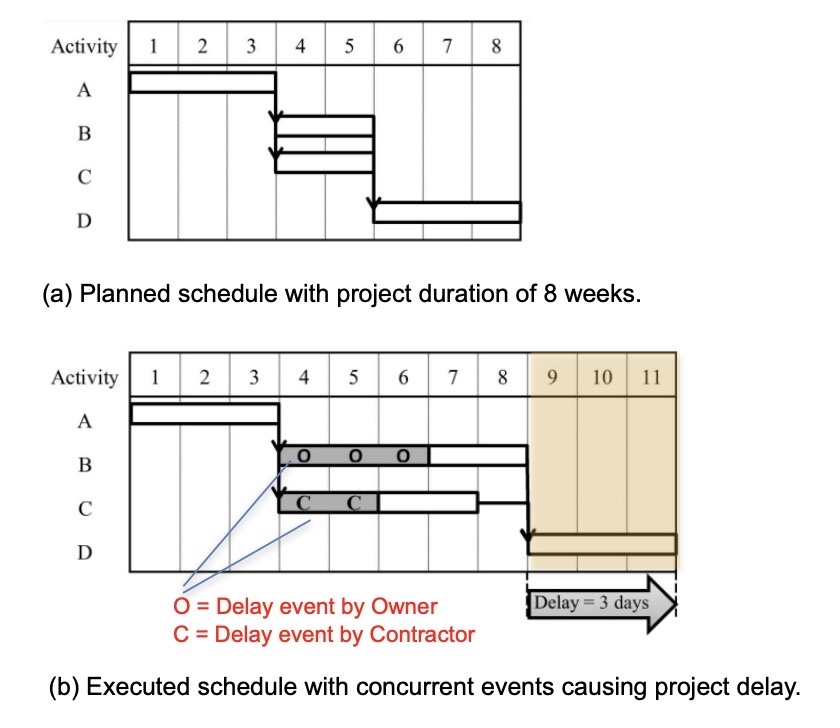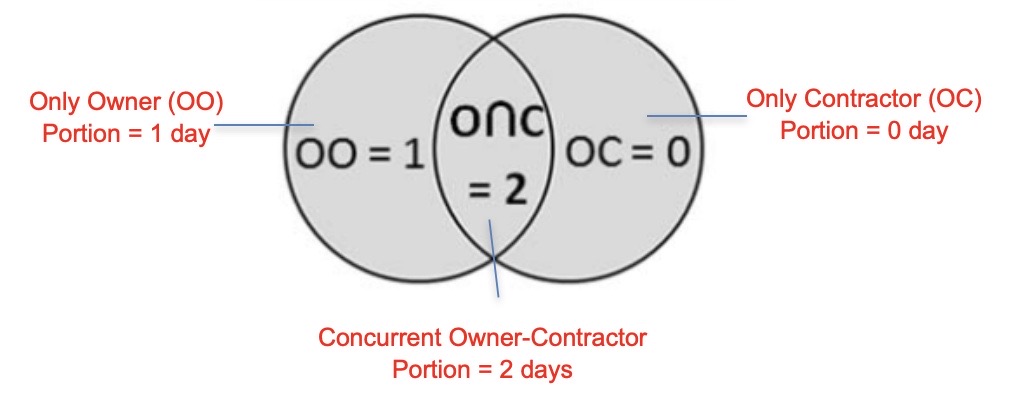On average, 72% of construction projects experience delays, with the original contracted duration increasing by 38%. Among these delays, concurrent delays present a particularly complex challenge.
They disrupt the scheduled flow of construction projects, lowering the expected profits, and often leading to complicated processes involving construction litigation. Knowing this is vital for those handling disputes and trying to keep a project on track.
Documenting Delay Events
In construction projects, delays do not only happen due to events by one party (i.e., owner or contractor) but also concurrently due to events by both parties. Concurrent delays occur when multiple setbacks happen simultaneously.
These concurrent delays make it difficult to analyze the allocation for delay responsibility and the consequent liability, compensation, and project extension decisions.
Look at the demonstration example below of a small 8-day plan that experienced execution delay events by both parties at different times to different activities, as shown.
Read more: Construction Progress Tracking: Why, What & How?
The result is a 3-day project delay, as shown in Fig. 1. Even for this tiny, simplified example, it is not easy to determine the portion of the 3-day project delay is attributed to each party (owner and contractor). This demonstrates the importance of properly documenting all progress events accurately and timely on the day they occurred, along with recording the related reasons and any support documents such as communication letters, photos, etc.

In any construction project, there can be many reasons for each party to cause work delay event. A summary of some key reasons is shown in Fig. 2. Typically, owner-related causes justify time extension and money compensation to the contractor.
Contractor causes, on the other hand, are neither compensable nor entitles the contractor to time extension.
When a third party-related event (extreme weather, strike, or other unexpected events) occurs, it usually entitles the contractor to time extension but not monetary compensation.
Also, when it is proven that concurrent events simultaneously caused a project delay, shared allocation can be determined. These, however, are general rules and complex situations may require some negotiations to resolve any disputes. A brief discussion of top ten causes is as follows:

Owner related causes:
- Design Changes: Modifications to the project design during construction can lead to delays as plans are revised and approved.
- Permit and Approval Delays: Delays in obtaining necessary permits and approvals from regulatory bodies can stall construction progress.
- Differing Site Conditions: Discovery of unexpected conditions like contaminated soil, underground utilities, or archaeological finds that were not conveyed to the contractor before bidding can require additional work and time.
Contractor related causes:
- Material Shortages: Lack of necessary materials due to supply chain issues, transportation delays, or manufacturing problems can cause project slowdowns.
- Labor Shortages: Insufficient skilled labor due to high demand, strikes, or other workforce issues can lead to delays.
- Equipment Failures: Breakdowns or unavailability of critical construction equipment can halt work temporarily.
- Financial Issues: Delays in funding or budget overruns can halt progress until financial issues are resolved.
- Subcontractor Delays: Delays from subcontractors, whether due to their own scheduling issues or coordination challenges, can impact the overall project timeline.
Read more: What Is Fast-Tracking in Construction? All What You Need to Know
Third-party related causes:
- Weather Conditions: Unexpected weather events, such as heavy rain, snow, or extreme temperatures, can halt construction activities.
- Labor Strikes: Unexpected strike events can halt construction activities.
Analysis and Resolution: How Opteam can help?
Analyzing project delays requires a systematic approach to identify the root causes and the sequence of events leading to the delays.
The accuracy of the analysis depends on the accuracy by which progress events are recorded, including daily reports, meeting minutes, and correspondences. A critical aspect of resolving disputes is effective communication among all stakeholders.
Open lines of communication can help in identifying potential delays early and addressing them before they escalate. Establishing a protocol for documenting and reporting delays ensures that all parties are aware of the issues as they arise.
This transparency not only aids in the timely resolution of delays but also fosters a collaborative environment where stakeholders can work together to find solutions.
Utilizing Opteam’s add-on software enhances the accuracy of both progress recording and delay analysis.
Upon recording the delay events on the school, Opteam’s analysis tools accurately assess both delays and accelerations in cases of two-party events, three-party events, and multiple baseline updates. This allows for a clearer visualization of activities and impacts. Opteam’s analysis methods are discussed in a separate article.
However, the main concept is to apply Venn analytics to determine the delay responsibility, as shown in Fig. 3.

Concurrent Delay Analysis Methods
Concurrent delay analysis can be a bit tricky, but let’s keep it super simple. Imagine two kids running a race, and both stop at the same time because one trips over a rock and the other stops to tie their shoe.
Who’s to blame for the delay? That’s what concurrent delay analysis is all about—figuring out how to split the responsibility when more than one thing causes a project to slow down.
Here are the basic methods to understand it:
- Cause and Effect
This method looks at each delay (like the rock and the untied shoe) to see if they happened at the same time and how they affected the finish line. - Window Analysis
Think of this like checking a race in chunks. It breaks the timeline into windows and checks for delays in each section. Did both kids have issues in the same window? - Time Impact Analysis
This one’s like running a simulation. You pause, add the delay (rock, untied shoe) to the timeline, and see what happens to the finish line. - As-Planned vs. As-Built
This is like comparing the race plan to what actually happened. If the kids planned to finish in 10 minutes but took 15, you compare the two to find where the delays overlapped.
In short, it’s all about spotting what caused the slowdowns and figuring out who’s responsible for what. Easy, right? 😄
Concurrent Delay Construction Example
Alright, let’s break it down with an example that’s easy to picture:
The Scenario:
You’re building a house. The contractor was supposed to install the roof, and the homeowner was supposed to finalize the window designs by a certain date.
What Happened:
- Roof Installation Delay:
The contractor didn’t install the roof on time because there was a shortage of roofing materials.
🚧 Delay: 2 weeks. - Window Design Delay:
At the same time, the homeowner took longer than expected to decide on the window designs.
🚪 Delay: 2 weeks.
The Impact:
Both delays happened during the same 2-week period, and they pushed the project timeline back. This is concurrent delay—when two delays overlap and cause issues.
Who’s Responsible?
- If the roof delay alone happened, the contractor might be blamed.
- If the window delay alone happened, the homeowner would be responsible.
- But because both happened at the same time, it’s harder to assign responsibility. Depending on the contract and delay analysis method used, the outcome might be:
- Shared Responsibility: Both parties caused the delay.
- No Extension of Time: If the delays cancel each other out, neither party gets extra time.
This is why analyzing concurrent delays is such a big deal in construction projects—it’s about fairness! 😊
Conclusion
Your skill in analyzing complex delay situations is key to keeping projects on track. It also helps avoid complex legal disputes that can emerge.
Detailed progress documentation and delay analysis tools such as Opteam’s add-on software are essential to carefully map out the intertwined schedules and legal issues in construction contracts. The impact of concurrent delays on construction litigation is significant.
Legal considerations play a significant role in the resolution of delays. It is essential to have a clear understanding of the contract terms related to delays and extensions of time.
Consulting with legal experts who specialize in construction law can provide valuable insights into liability and help in drafting contract provisions that address potential delays.
Additionally, investing in training for project managers and staff on best practices for delay analysis and resolution can improve their ability to manage and mitigate delays effectively, ultimately keeping projects on track.


